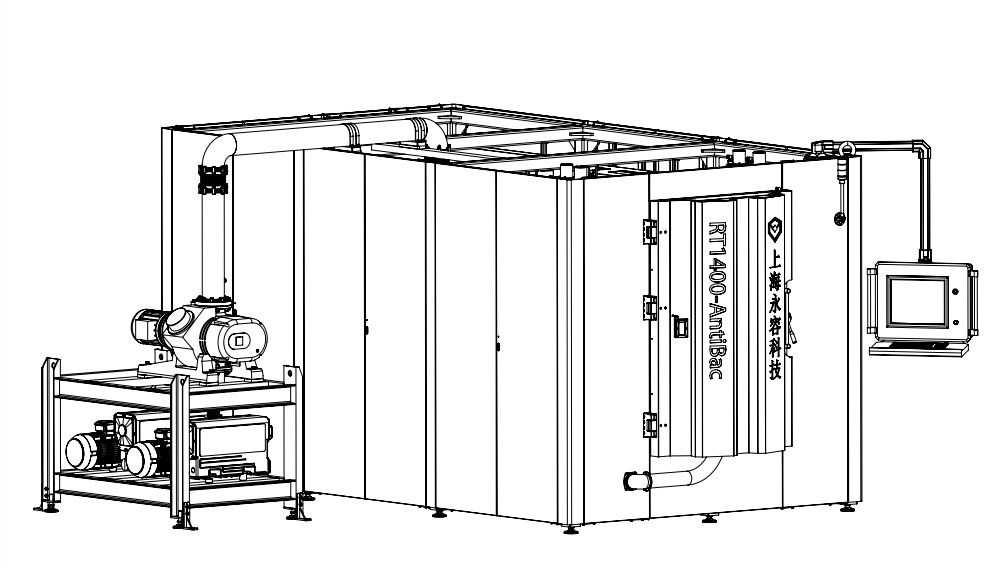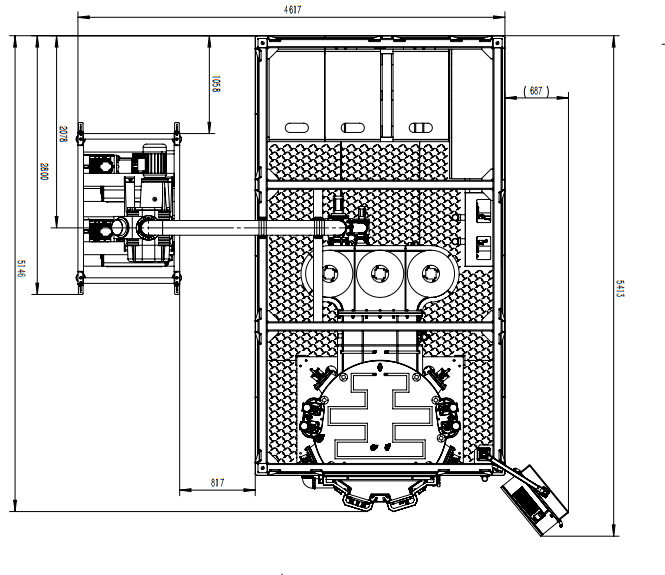By combining the capabilities of arc evaporation and MF magnetron sputtering, the hybrid deposition system can offer a unique set of advantages that cater to specific thin film deposition requirements, making it a valuable tool for industries and research domains seeking to achieve specialized thin film properties and compositions.
Advantages
Enhanced Film Properties: By combining arc evaporation and MF magnetron sputtering, it is possible to create thin films with unique and tailored properties that may not be easily achievable with either technique alone. This combination allows for a wider range of film compositions and structures.
Improved Adhesion: Arc evaporation can provide good adhesion properties, while MF magnetron sputtering can further enhance adhesion by promoting intermixing at the interface between the film and the substrate.
Film Composition Control: The hybrid system allows for precise control over the composition of the deposited films, enabling the production of complex multilayer structures and materials with specific properties.
Versatility: The combination of arc evaporation and MF magnetron sputtering offers versatility in depositing a wide range of materials, including metals, alloys, oxides, nitrides, and more, making it suitable for diverse applications.
Enhanced Control: The system provides enhanced control over film thickness, composition, and structure, allowing for the production of tailored thin films with desired properties such as hardness, wear resistance, and optical characteristics.
Efficiency and Productivity: The hybrid system can offer improved efficiency and productivity in thin film deposition processes by leveraging the strengths of both arc evaporation and MF magnetron sputtering techniques.
Synergistic Effects: The combination of arc evaporation and sputtering can lead to synergistic effects, where the advantages of each technique complement and enhance the overall deposition process, resulting in high-quality thin films.
Customized Applications: The hybrid system is particularly useful for applications that require precise control over film properties, adhesion, and composition, such as in electronics, optics, coatings, and advanced materials.
By combining the capabilities of arc evaporation and MF magnetron sputtering, the hybrid deposition system can offer a unique set of advantages that cater to specific thin film deposition requirements, making it a valuable tool for industries and research domains seeking to achieve specialized thin film properties and compositions.
What materials are commonly deposited using this hybrid system?
The combination of arc evaporation and mid-frequency (MF) magnetron sputtering in a hybrid deposition system offers versatility in depositing a wide range of materials with unique properties. Some common materials that are often deposited using this hybrid system include:
Metallic Alloys: The hybrid system can be used to deposit metallic alloys with controlled compositions, offering properties such as improved hardness, corrosion resistance, and electrical conductivity.
Oxides: Oxide materials like indium tin oxide (ITO) or titanium dioxide (TiOx) can be deposited using this system for applications in transparent conductive coatings, sensors, and photovoltaics.
Nitrates: Nitride materials such as titanium nitride (TiN) or aluminum nitride (AlN) can be deposited for applications requiring hardness, wear resistance, and thermal stability.
Diamond-Like Carbon (DLC):The hybrid system can be utilized to deposit DLC coatings, which offer properties such as high hardness, low friction, and chemical inertness.
Multi-layer Structures: By combining arc evaporation and MF magnetron sputtering, complex multi-layer structures can be deposited, allowing for tailored properties like adhesion, hardness, and optical characteristics.
Semiconductor Materials: Materials like silicon (Si), germanium (Ge), or compound semiconductors can be deposited for applications in electronics, opto-electronics, and photovoltaics.
Dielectric Materials: Dielectric materials such as silicon dioxide (SiOx) or aluminum oxide (AlxOx) can be deposited for applications in insulation, optical coatings, and electronic components.
Magnetic Materials: Magnetic materials like iron (Fe), cobalt (Co), or nickel (Ni) can be deposited using this system for applications in data storage, sensors, and magnetic devices.
Organic and Polymer Films: The hybrid system can also be used to deposit organic materials and polymer films for applications in flexible electronics, displays, and protective coatings.
The versatility of the arc combine MF magnetron sputtering deposition system allows for the deposition of a diverse range of materials, enabling the production of tailored thin films with specific properties for various industrial applications.
The flexibility in material selection and deposition control makes this hybrid system valuable for researchers and industries seeking precise control over thin film properties and compositions.
Here are some key aspects related to such a combined deposition machine:
Features
Arc Evaporation:
The arc evaporation technique involves using an electric arc to vaporize the target material, creating a plasma that deposits the material onto the substrate.
MF Magnetron Sputtering:
Mid-frequency (MF) magnetron sputtering utilizes a medium-frequency power source to sputter target material atoms onto the substrate.
Hybrid Deposition:
By combining arc evaporation and MF magnetron sputtering, the system can achieve unique film properties and compositions that may not be easily attainable with either technique alone.
Multiple Deposition Sources:
The machine likely includes both arc evaporation sources and MF magnetron cathodes to enable deposition from multiple sources.
Controlled Parameters: The system allows for precise control over deposition parameters such as power, pressure, and substrate temperature to tailor the properties of the deposited thin films.
Film Composition Control: The combination of arc evaporation and sputtering can offer enhanced control over film composition and structure, leading to tailored material properties.
Advantages
Versatility: The hybrid system can accommodate a wider range of materials and deposition requirements compared to using each technique individually.
Customized Film Properties: By combining different deposition methods, the system can create films with unique properties not easily achievable with a single technique.
Improved Adhesion: The combination of techniques can enhance film adhesion to the substrate, leading to improved film quality.
Enhanced Control: The system provides enhanced control over film thickness, composition, and structure, allowing for the production of tailored thin films.
Efficiency: The combined system can offer improved efficiency and productivity in thin film deposition processes.
An arc combine MF magnetron sputtering deposition machine is a versatile tool for creating specialized thin films with controlled properties. By integrating different deposition techniques, the system can offer flexibility in material selection and film characteristics, making it suitable for a variety of applications in industries such as electronics, optics, and coatings.
The machine is designed and manufactured strictly following CE standards.
1. Integrated design structure, impact footprint.
2. Advanced cylinder sputtering cathode design, high utilization of target over 80%
3. High ionization rate, high density of deposited film
4. Multiple compound coating processes are available
5. One-Touch auto coating system, equipped with IPC program
6. Planetary driving of rotary rack for high yield
7. Powerful vacuum pumps package for shorter cycle time,energy saving, lower production cost
The below technical parameters are only for reference, Royal Technology reserves the right for final production based on specified applications. We provide you not only the coating machine but the total coating solutions, and turnkey-project service is available.
| Model | RTAS1000 | RTAS1400 | RTAS1612 |
| Effective Chamber Size | Φ1000 x H1000mm | Φ1400 x H1600mm | Φ1600 x H1250mm |
| Deposition Sources |
Cylinder Arc (steered circular arc for option) + DC Sputtering Cathode + Linear Ion Source(for option) + MF cylinder sputtering cathodes |
||
|
Vacuum Pumping System ( Leybold Pumps + Turbo Molecular Pump)
|
SV300B *1 set (300m3/hr) | SV300B* 2 sets (300m3/hr) | SV300* 2 set (300m3/hr) |
|
WAU501-1set (1000m3/hr) |
WAU2001-1set (1000m3/hr) |
WAU2001-1set (1000m3/hr) |
|
| TRP48*1 set (48m3/hr) | TRP90*1 set (60m3/hr) | TRP90*1 set (90m3/hr) | |
|
Turbo Molecular Pumps: 1 set (3500L/S) |
Turbo Molecular Pumps: 3sets (3500L/S) |
Turbo Molecular Pumps: 3 sets (3500L/S) |
|
| Sputtering Power Supply | 1*24KW | 2*36KW | 2*36KW |
| Arc Power Supply | 6*5KW | 14*5KW | 14*5KW |
| Bias Power Supply | 1*24KW | 1*36KW | 1*36KW |
| Planetary Rods | 6/8 | 12/16 | 20 |
| Ultimate Vacuum | 9.0*10-4Pa (empty, clean, room temperature) | 9.0*10-4Pa (empty, clean, room temperature) | 9.0*10-4Pa (empty, clean, room temperature) |
| Cycle Time (depends on pump) | 40’~50’ depends on the substrate material and coating recipes | ||
| Working Power Requirement |
3Phase 5 lines AC380V,50HZ,55KW |
3Phase 5 lines AC380V,50HZ,110KW |
3Phase 5 lines ,AC380V,50HZ,150KW |
| Cooling Water | Recycle cooling water, industrial water chiller + EDI purified water device | ||
| Processing Gas (99.99%) | 4 ways | 4 ways | 4 ways |
| Footprint (mm) | 2000*2000*2500 | 4000*4500*3200 | 5500*5000*3200 |
| Total Weight(KGS) | 4500 | 7000 | 9000 |
| Total Power Consumption(Approx.) | 50KW | 110KW | 150KW |
| Actual Power Consumption(Approx.) | 30KW | 60KW |
70KW |
Layout




Machine Model: RTAS1400
Project Time: 2021
Project Location: Lebanon


